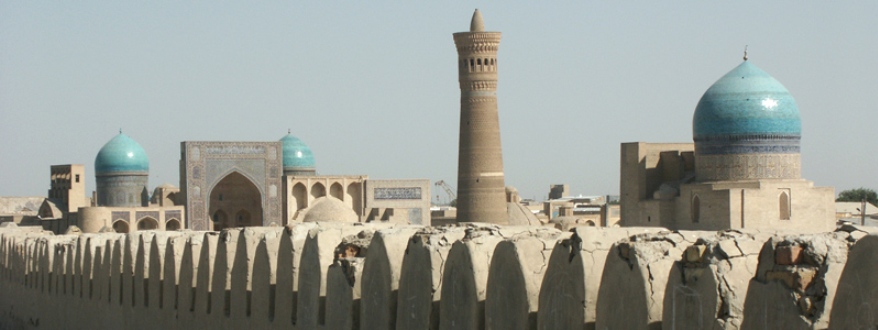Bukhara

The Bukhara district is located in the southwest of Uzbekistan, in the territory that measures 39,400 km2. The main part of the district is occupied by Kyzyl-Kum Desert. The climate in this region is dry continental. The population in the districts 11 regions measures around 1.5 million people. Bukhara is one urban center, with a population of around 263,400 people. Another tourist center in the district of Buhkara is the city of Gizhduvan.
By the decision of the United Nations Educational, Scientific and Cultural Organization (UNESCO) Bukhara was included on the list of the world's most impressive scientific and cultural treasures. “Bukhara-i-sharif,” which means “noble Bukhara,” is the name given to Bukhara in the Muslim east.
Bukhara is one of the most ancient cities of Uzbekistan, situated on a sacred hill. It is one of few cities that developed in the original site from the 5th century b.c. The name of Bukhara originates from the word “viraha” which means “monastery” in Sanscrit. This is the only city in Central Asia where the unique historical atmosphere has been kept whole. Bukhara is a museum city: more than 140 architectural monuments of world significance, constructed in different centuries, have been preserved in Bukhara to today. Its ancient walls store the memories of 25 centuries of history, and the reigns of various rulers both successful and unsuccessful.
Unique Bukhara has been restored once again into a fertile oasis and scientific and cultural center on the Great Silk Road. Trade cupolas constructed during 15th and 16th centuries—Toki-Sarrafon (cupola of moneychangers); Toki-Telpak-Furushon (cupola of headdress sellers); and Toki-Zargaron (cupola of jewelers)—are a good testimony to Bukhara's location just on the caravan crossroads.
Many scientists and philosophers were from Bukhara. It was here that the great Sheikh Bohouddin Nakshbandi lived. He was a central figure in the development of the mystical Sufi approach to philosophy, religion and Islam. The scientific center for studying the heritage of Bohouddin Nakshbandi operates here.
Main part of Bukhara's center is so called “architectural area”: a lot of former madrassas are located here including Madrassa Chor-Minor and citadel Ark, Madrassa Ulugbek, and Kukeldash. Walking along the narrow and shady streets, one can reach Poi-Kalyan Square with the Kalyan Minaret in the center. Built in 1127, it is still known as the “Great Minaret,” with its ingenious engineering construction which reaches 47 meters into the sky.
The numerous palaces, mosques, mausoleums, and minarets are unsurpassed in their beauty, making the ancient city of Bukhara unforgettable in its history and splendor.


